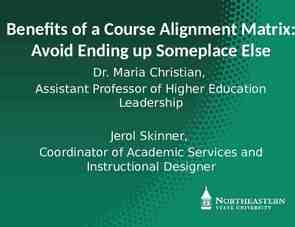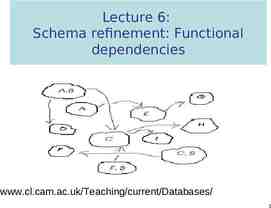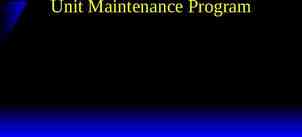Foundations of teaching and learning By Professor Namir
63 Slides1.45 MB

Foundations of teaching and learning By Professor Namir Al-Tawil M.B.Ch.B., FICMS, FFPH [email protected] Oct 17, 2016

Contents Difference between teaching and learning. Bloom’s cognitive taxonomy of learning. Important principles of teaching. Teaching and learning methods: –Lectures. –Learning in small groups. –Teaching in the clinical skills center. –Bedside teaching. –Ambulatory care teaching. –In the community. –Distance education. –Peer-assisted learning.

Objectives At the end of this lecture the audience must know: Important principles of teaching. The main methods of teaching and learning. Know the advantages and disadvantages of each.

Teaching vs. learning TEACHING is the process done by the TEACHER . LEARNING is the process done by the STUDENT: – Learning is something students do themselves. – The teacher is the facilitator of this process. – Learning involves change in knowledge, beliefs, and attitudes. – Learning takes time and (if successful) has a lasting impact.

Paradigm shift Transactional teaching (old) – the teacher conveys information. – the students are expected to assimilate the knowledge on their own Transformational teaching (new) – The teacher is the facilitator. – Active engagement of students.

Bloom’s Cognitive Taxonomy of Learning

Important principles of teaching

1. Prior Knowledge You need to teach at the right level for the students to learn New knowledge “sticks” better when connected to prior knowledge. You can never underestimate the students’ prior knowledge. Insufficient or inappropriate prior knowledge can hinder learning

2. Knowledge Organization The teacher has a highly organized view of the knowledge. The students do not. Knowledge that is not connected to other knowledge is more easily forgotten Always connect new knowledge to prior knowledge

3. Motivation Students have to have a goal in order to be motivated and the goal has to have value. – Attainment value (mastery) – Intrinsic value (confidence, self-esteem) – Reward value Motivation is high if student realistically believes he/she is able to attain the goal and the goal has high value.

4. Integrating Knowledge To develop sustained learning, students must: – acquire specific component skills – practice integrating ( expanding) them into new situations – know when to apply the skills. Reach cognitive taxonomy level 3 (apply) Goal of learning (higher education) should be to reach at least this level Too often teaching only focusses on component skills and ignores integration

Elements of mastery

5. Feedback Effective feedback: –teach limited objective –Get feedback if students have learned the objective. Talk with them Questions quiz Clickers Listen to group discussions Home work Be willing to adjust your teaching –Tests are not necessarily great feedback mechanisms Does provide overall feedback –But often too late to change teaching for current students –

6. Learning Climate Student’s current development level interacts with the social, emotional, and intellectual climate of the learning (“Classroom”) environment to impact the learning. Be in control of the situation, but don’t be too authoritative and unapproachable Connect with the students (but not too much!) Be interested in them. Understand the different backgrounds of the students.

6. Learning Climate, cont. Encourage positive interactions and discourage negative interactions Don’t just teach for the best students Be encouraging even if students answer incorrectly

7. Self-evaluation and self-direction To become self-directed learners, students must learn to monitor and adjust their approaches to learning. – Encourage students’ metacognition: “The process of reflecting on and directing one’s own thinking”. – Help students to recognize internal issues (and not just blame external issues). – Make them “lifelong” learners. – Increasingly important on the higher levels of the cognitive taxonomy

Teaching and learning methods

I. Lectures

Lecture A process by which the notes of a teacher become the notes of a student without passing through the minds of either. O’Donnel 1997

II. Learning in small groups

III. Teaching in the clinical skills center

Objective The clinical skill center (CSC) seeks to provide an environment for learning clinical skills in which students can practice without jeopardizing patient care or provoking adverse effects.

Current trends I. Developing simulated clinical environment Requirements: Space for creation of simulated environments. Simulators of varying degrees of sophistication. Simulated and standardized patients and patient-instructors.

Space The clinical skills center should provide more space than the ordinary (real) hospital rooms. Requirements: Separate restroom facilities for simulated patients (SP). A briefing room where SP can relax, eat, and store their belongings and be briefed as a group by SP trainer.

Space, cont. A seminar room. Office space. A monitoring station. Room temperature. Lighting. Air-conditioning, fire alarm, soundproofing, and emergency lighting. A photocopier, and fax. An audio-visual presentation room, with teleconferencing capacity. Storage space for models and simulators.

II. Simulators Simple models are used to simulate intimate or invasive procedures such bladder catheterization, rectal, and breast examination. More complex simulators allow students to perform intravenous cannulation and intraarticular injections. The latest generation combine the model and a computer generated performance indicator. e.g. simulators for pelvic examinations, and cardiology simulators.

III. Simulated and standardized patients Individuals of all ages can be trained to reproduce a clinical history and to respond to physical examination in a consistent manner. They can also assess the care provider’s performance.

IV. Bed side teaching

Bedside teaching “To study the phenomenon of disease without books is to sail an uncharted sea whilst to study books without patients is not to go to sea at all” Sir William Osler 1849-1919

The learning triad Patients Doctors Students

Patients Direct contact with patients is important for the development of clinical reasoning, communication skills, professional attitudes, and empathy. It is valuable to start with simulated patients (normal anatomy and physiology). Patients should not be obliged to participate in the teaching sessions. Patients should be briefed, so that they know what will be expected of them.

Students The optimum No. of bedside teaching is 2-5 students. They must be dressed with hospital uniform and name badges. They are expected to behave professionally in the ward. They should be briefed in the beginning about the purpose of the session and goals to be achieved.

Students, cont. Students have found ward based teaching the most valuable way of developing clinical skills. In the beginning, students may feel a state of fear and embarrassment of an unfamiliar environment. They may feel anxious if unsure of their knowledge base or clinical abilities. The tutor must help to relieve anxiety and let “all” students participate in the session.

Tutors Tutors may be consultant staff, junior hospital doctors, nurses, trained patients, or student peers. Tutors are powerful role models for the students especially in the early years. It is important that they demonstrate appropriate knowledge, skills, and attitudes.

The ward Ward teaching should not take place when meal, cleaners, or visitors are expected. The use of side room for pre- or postward round discussion provides a useful alternative venue for discussion once the patients have been seen.

Educational objectives Clinical skills. Communication skills. Clinical reasoning. Practical procedures (venepuncture, bladder catheterization, cannulation). Patient investigation and management. Professional skills (the observation of doctors and how do they deal with each other and with other health care workers). Attitude and ethics.

V. Ambulatory care teaching

Why teach in ambulatory care The ambulatory care setting offers a variety of clinical situations and a range of common clinical conditions not seen in inpatient care.

Where can teaching take place General OP clinics. Specialist or tertiary referral clinics. Multi-professional clinics (staff from variety of disciplines see patients together e.g. hand clinics) Clinics for specific diseases like diabetes clinic and foot clinics. Accident and emergency department. Radiology and imaging suites.

Where can teaching take place Clinical investigation unit e.g. endoscopy unit. Day surgery unit. Physiotherapy and departments of other professions allied to medicine . Social services department. Ambulatory care teaching center.

How to facilitate learning in ambulatory care Logbooks: used to list the core clinical problems to be seen during the attachment and to document the student activity and learning achieved with each patient contact. Task-based-learning: A list of tasks are given to the students: participate in consultation with the attending staff, interview and examine patients, review a number of new radiographs with the radiologist.

Advantages of teaching in the ambulatory care setting A wide range of clinical conditions may be seen. There are large numbers of new and return patients. Students have the opportunity to experience a multi-professional approach to patient care. Unlike ward teaching, increased numbers of students can be accommodated without exhausting the limited No. of suitable patients.

Advantages of teaching in the ambulatory care setting Students enjoy this teaching situation and probably prefer it to ward-based teaching. Medical schools should recognize the role ambulatory care teaching has in relieving pressure on ward-base teaching and provide appropriate resource for its implementation and development.

VI. Community Based Medical Education (CBME)

Definition CBME refers to medical education that is based outside a tertiary or large secondary level hospital. Community oriented medical education describes curricula that are based on addressing the health needs of the local community and preparing graduates to work in that community.

Setting Most CBME curricula are based on a PHC philosophy and are conducted in a primary care setting.

Uses for CBME Preclinical aims: Learning in the fields of epidemiology, preventive health, public health principles, community development, the social impact of illness and understanding how patients interact with the health care system. Also used for learning basic clinical skills, especially communication skills.

Uses for CBME, cont. Clinical aims. 1.To learn about general practice. A general practice rotation is the most common clinical CBME attachment and appear in most modern medical curricula.

Clinical aims, cont. 2.To learn multiple disciplines concurrently. - This concept takes advantage of the broad patient base in primary care, and has been situated in rural communities. - Clinicians are more likely to have significant roles in primary care, emergency medicine, obstetrics, and inpatient care.

VII. Distance education

Definition The term ‘distance education’ covers the various forms of study at all levels which are not under the continuous, immediate supervision of tutors present with their students in lecture rooms, or in the same premises, but which nevertheless, benefit from the planning, guidance, and tuition of tutorial organization. Holmberg 1997

Why distance education? It is an excellent alternative to continuing medical education courses when there are certain constraints like time, funding, and geography. Distance education can allow learners to study a topic to the depth they desire and at a pace that suits them.

VIII. Peer-assisted learning (PAL)

Definition of Peer Assisted Learning Any situation where people learn from, or with, others of a similar level of training, background or other shared characteristic. In the undergraduate curriculum this could include any small group work (e.g. problem based learning). In postgraduate medicine, e.g. peer review of journal articles, clinical team meeting and appraisal.

Advantages Advantages for tutors: Provides opportunities to reinforce and revise their learning. Encourages responsibility and increased selfconfidence. Develops teaching and verbalization skills. Enhances communication skills, and empathy. Develops appraisal skills (of self and others) including the ability to give and receive appropriate feedback. Enhance organizational and team-working skills.

Advantages, cont. Advantages for tutees Feel more relaxed, and more supported. Can ask questions, even the silly ones. Provides opportunity to obtain detailed feedback on their knowledge and skills. Associated with social benefits, role modeling, and increased motivation to learn. It is efficacious: peer tutors seem to be as good as staff in certain areas.

“The peer tutors were great teachers. They are students as well, so they know what and how we think, the mistakes we tend to make” Tutee (Howman et al 2003)

Advantages, cont. Advantages for medical school Cost and resource-effective. Students feel more involvement in the course and ownership. It is easier to standardize tutoring from peers than from professional teachers. Meets obligation to train medical students in teaching skills. Encourage a culture of collaborative learning instead of competitiveness.

Disadvantages of PAL Student tutors may have inadequate depth of knowledge and experience. They may teach ‘the wrong thing’ or they may poorly transfer the skills. Tutors’ ego and personality issues may cause groups to be dysfunctional. Time and effort are required to organize PAL programs, train tutors, and monitor outcomes.

Summary More than one teaching method is needed. There is movement from a teacher-centered approach of education to a more student centered approach.

Questions and comments ? ? ?

Thanks for listening







